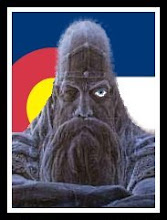 Cheyenne Wells,
Cheyenne Wells,4 December 2010
We woke at "O" dark thirty, brewed coffee, stuffed aging bodies into well worn hunting clothes, pulled out rifles and headed out into the cold. The sun was just beginning to color the eastern horizon. Mark pulled off the road and parked under the familiar bridge. We were set to walk a living snow and wind break. Russian Olive, Scrub Cedar, Sand Plum and Ponderosa planted half a century ago create a wind break wall to the north of the ranch buildings and corrals.
It is also a favorite hide out for deer and pheasant.
Walking east on the sandy floor of the arroyo, we turned south, up through dry grasses and sage, up onto the gentle rise that led to the eastern end of the trees. Mark would walk the north side, I would walk the south, watching and listening for a telltale rustle in the trees ahead. Just as we rose out of the arroyo, the sun broke the eastern sky, blazing through the thin clouds and vapor trails.
Walking the tree line east to west, we neither heard nor saw tracks or spoor. Not one pheasant cackled, only the small finches, thrushes and juncos that inhabit the plains. No sign of deer, no beds of crushed grass, we found nothing.
Back in the truck, we headed east on dusty section roads. Cut corn next to a field of cut sunflowers rolled to the north, and there out in the center, we saw our first deer. A group of five does, mule ears alert began to "pronk" (the muley's peculiar manner of bouncing up and down) as the spied us, some 400+ yards out.
Then it began. They ran, nonstop until they were mere specks on the horizon. THAT is not the usual behavior of mule deer. Unless they are chased or shot at, mule deer normally will mill about, then run a short distance, stop and reassess the situation, mill about more and perhaps run another short distance before beginning to feed.
We drove section roads all morning, seeing somewhere between 24 to 27 deer in small groups of 3 to5 animals. AND...each group behaved the same. The minute they saw our truck, they ran as though the hounds of hell were on their heels. We had no chance to take a shot under four or five hundred yards.
It is also a favorite hide out for deer and pheasant.
Walking east on the sandy floor of the arroyo, we turned south, up through dry grasses and sage, up onto the gentle rise that led to the eastern end of the trees. Mark would walk the north side, I would walk the south, watching and listening for a telltale rustle in the trees ahead. Just as we rose out of the arroyo, the sun broke the eastern sky, blazing through the thin clouds and vapor trails.
Walking the tree line east to west, we neither heard nor saw tracks or spoor. Not one pheasant cackled, only the small finches, thrushes and juncos that inhabit the plains. No sign of deer, no beds of crushed grass, we found nothing.
Back in the truck, we headed east on dusty section roads. Cut corn next to a field of cut sunflowers rolled to the north, and there out in the center, we saw our first deer. A group of five does, mule ears alert began to "pronk" (the muley's peculiar manner of bouncing up and down) as the spied us, some 400+ yards out.
Then it began. They ran, nonstop until they were mere specks on the horizon. THAT is not the usual behavior of mule deer. Unless they are chased or shot at, mule deer normally will mill about, then run a short distance, stop and reassess the situation, mill about more and perhaps run another short distance before beginning to feed.
We drove section roads all morning, seeing somewhere between 24 to 27 deer in small groups of 3 to5 animals. AND...each group behaved the same. The minute they saw our truck, they ran as though the hounds of hell were on their heels. We had no chance to take a shot under four or five hundred yards.
 Mark pulled up next to a familiar old ruin with a working wind mill. Its a great place to scope the surrounding prairie. We ate lunch and Mark clambered up the structure with his binoculars, seeking the elusive deer. He did see some dark shadows off to the west, across the state highway.
Mark pulled up next to a familiar old ruin with a working wind mill. Its a great place to scope the surrounding prairie. We ate lunch and Mark clambered up the structure with his binoculars, seeking the elusive deer. He did see some dark shadows off to the west, across the state highway. We headed west, no luck. We walked the sides of arroyos, glassing the deep pockets and long sandy draws for any deer. Nothing moved. It was as though all the game had just, simply, inexplicably disappeared! It was eerie, very strange.
Heading east, back towards Kansas, Mark turned a corner towards Highway 385. The truck died. No warning, it just stopped running. He tried to start it. Plenty of cranking power, obviously it wasn't the alternator or charging system. We popped the hood, scrambled underneath seeking some indication of problem. It all looked normal. Outside of Cheyenne Wells on a December, Saturday afternoon...NOT the best place to be marooned with a dead truck. We made phone calls. All the shops were closed. One convenience/gas store was open, nothing else.
Mark tried to start it again. The truck coughed and turned over, running as though nothing had happened. We gingerly drove back to the motel. Again, it was eerie, very strange.
Clearly, we were not going to chance heading out into the prairie with a vehicle that was not reliable. We packed up our belongings, had a couple of drinks, ate dinner and went to sleep. Tomorrow we would begin the nearly 200 mile run back to Denver, hoping and praying that the truck would make it home.




Some of the best hunting days I ever had didn't result in any "finding." But for that to happen it all has to come together in ways that non-hunters don't savvy.
ReplyDeleteWhen your vehicle gets hinky out here you truly understand why men were hung for stealing another man's horse.